COVER- Off-campus and at risk: The hidden fire danger for students

"She could brighten a room just by entering it," says Doug Turnbull of his daughter Julie, who died in a house fire in Oxford, Ohio in April 2005, one month before her graduation. "We used to tease Julie and say, 'It's not all about you,' Turnbull recalls. "But for us, it is still all about Julie."
FAMILY PHOTO

" She graduated national honors, was homecoming queen, and was writing about the Taliban and women's rights before 9/11 even hit," says Dennis, of his daughter Andrea, who died in an Ohio house fire in April 2003. "She was always taking care of people, staying up late until everyone got in. She died because she went to bed earlier than other kids. She would not have slept through a smoke alarm," Dennis believes. "She would have heard it and bolted out of there.
FAMILY PHOTO
Doug Turnbull remembers the day he took his daughter Julie back to college to move into an off-campus house. After the heavy lifting was done, he paused to ensure she'd be able to escape if a fire broke out.
"I checked the windows to make sure they weren't painted shut," he says. "I reached up and tested the smoke detector to make sure it was working."
It's a ritual repeated by parents all over the country thousands of times each year, as they help their almost-grown children settle into college dwellings.
"You wander around and see where they're going to live," he explains. "It's mostly curiosity. You're pushing buttons, checking around." Figuratively, he says, "It's your last parental act."
For Turnbull, the memory of that moving day is exquisitely painful because it really turned out to be his last parental act.
Julie Turnbull died in a housefire on April 10, 2005, exactly one month before her 22nd birthday and her graduation from Ohio University. The house in which she and two other students died was equipped with a stunning 17 smoke detectors– many, if not all, of them functioning.
The tragedy, and what Turnbull has learned since then, could prevent other parents from ever suffering the way he has. Repeated tests show that ionization smoke detectors– the type found in most American homes and college housing– don't actually detect the type of fire most likely to kill.
On-campus/off-campus
UVA's Kellogg residence hall is a far cry from dormitories of yore. With flat-screen televisions in lounges and wifi in every room, it's an example of 21st century college residence life. But Kellogg has another, lesser known technology that sets it apart from other residence halls at UVA and at universities across the country: photoelectric smoke detectors.
Four years ago, UVA voluntarily began upgrading the hardwired detector systems in all student-occupied buildings from ionization-technology detectors– the type now widely known to be plagued by false alarms, which lead people to disable their alarms – to photoelectric.
One-year-old Kellogg– home to first year students–- is one of three new dorms at UVA (the others are Cauthen and Woody) that were built with the new photoelectric systems. The change was made by the Office of Residence Life after students in older dorms complained repeatedly of false alarms, says Mark Doherty, UVA's Chief Housing Officer, who admits that the other eight residence halls still have only battery-powered ionization units. Those will eventually be replaced, he says, by photoelectric units, which typically cost a couple of dollars more.
This simple change, numerous fire safety experts say, may be the single most critical decision a university can make in keeping its students safe from fire. That's because in addition to a tendency to false alarms, repeated tests have shown that ionization detectors don't readily respond to smoke from smoldering fires, the type most likely to strike– and kill– when residents are sleeping.
Smoldering fires can be ignited by improperly extinguished cigarettes, but smokers aren't the only ones who need to worry. Faulty outlets or wiring can spark a smoldering fire. Even a candle left burning can lead to a smoldering fire, depending on the materials it ignites. Cotton, for instance, might flame instantly, while the synthetic fabric on modern furniture might smolder first, then ignite.
Once started, a fire can smolder for hours, filling a dorm room or house with carbon monoxide and other toxic gases. An ionization detector typically won't sound until actual flames erupt– often too late for residents, who've by then been incapacitated by smoke and gases, to escape.
Such may have been the case in Charlottesville when a fire broke out in the wee hours of March 18, 2007 in a Lewis Mountain Road duplex that had been the site of a St. Patrick's Day party. The horror was detailed in the Hook's April 17, 2008 cover story, "Smoldering Truth: Ashley Mauter's fight and a shocking fact about smoke detectors."
According to a survivor, the apartment was equipped with an ionization detector that sounded– too late. Brett Quarterman, age 25, died two days later of smoke inhalation without ever regaining consciousness. His girlfriend, Ashley Mauter, then 24, was burned over 30 percent of her body and is, to this day, struggling with disfiguring injuries.
Reached in New York in mid-August, where she was attending the annual World Burn Congress, a four-day event that brings burn survivors together, Mauter says she's doing well; but to reduce scar tissue and improve flexibility, she's facing more surgery.
"I've been avoiding it," says Mauter. "It's so nice to feel normal."
She notes that after her most recent surgery– in July 2008– she was wheelchair-bound for two and half months. Doctors next want to repair nerve damage and to loosen scar tissue in her foot to prevent her toes from curling up. She dreads returning to a wheelchair and taking the painkillers to which so many burn patients– Mauter included– have become addicted during recovery from their injuries.
It's impossible to know with any certainty if Mauter would have been spared her ordeal had the Lewis Mountain Road apartment been equipped with photoelectric detectors. Available data, however, suggests it's possible.
In repeated tests of the two detector types– including one test conducted by the Hook and local fire departments in June 2008– ionization detectors remained silent even as smoke and poisonous gases grew thick enough to obscure vision and require observers to don breathing apparatus. Such a scenario in a residence is a horrifying possibility that happens more frequently than some might imagine.
According to data from the U.S. Fire Administration, there are 1,500 on-campus or off-campus fires annually. Since 2000, according to the nonprofit fire safety publication Campus Firewatch, 135 college students have died in those fires. Hundreds more have been severely burned and permanently disfigured.
While UVA's smoke detector upgrade has undoubtedly made at least some students safer, the change offers nothing to protect the majority of UVA students, those who live in off-campus housing. It's a danger illustrated by the fact that of those 135 student deaths in the last nine years, 84 percent occurred in off-campus residences.
According to UVA spokesperson Carol Wood, 14,500 of UVA's approximately 21,000 students– about 70 percent– live off the Grounds in and around Charlottesville. In a survey of five of the largest of those off-campus housing developments, the Hook has confirmed that all are equipped with ionization detectors.
And considering that 90 percent or more of the smoke detectors in American residences are ionization, it appears that most apartment and rental houses in Charlottesville don't have photoelectric protection.
Students in those off-campus apartments are "terribly vulnerable," says Turnbull. He, unfortunately, knows all too well.
Two fathers, two fires
On April 10, 2005– Palm Sunday– Turnbull was hanging curtains in his suburban Cincinnati home and planning to visit 21-year-Julie an hour away at Miami University. Julie would be graduating exactly a month later on May 10– also her 22nd birthday. As he worked, Turnbull says, he looked forward to seeing his younger daughter.
"She had a great job lined up," he says, "and we were so proud of her."
His simple afternoon of domestic tasks was interrupted by two police officers at his door with terrifying news. There had been a fire the previous night at Miami University– a fire in the house where Julie was spending the night with friends after an evening out.
"They couldn't find her," says Turnbull, who didn't immediately understand the implication and says he was initially more concerned about the two students already confirmed dead. After all, he thought, Julie might not have been there.
The truth forced its way in, as the next day– "the worst day of our lives"– Julie's body was identified with dental records.
A week later, the grieving parents, Doug and his wife Linda, greeted guests at Julie's funeral. After receiving hundreds of mourners who'd known and loved Julie, a stranger introduced himself. That meeting would set the Turnbulls on a path they never imagined.
"I thought if I could approach them, they'd see that you can go on in life," says Dean Dennis, who was the stranger. Exactly two years before Julie Turnbull died, Dennis had lost his own college-aged daughter in another off-campus fire on Palm Sunday.
In April 2003, Dennis' daughter Andrea was a junior at Ohio University when she and some friends decided to take the hour-and-a-half road trip northwest to Ohio State University, to help a friend celebrate his 21st birthday. Following an evening party at a two-story off-campus house, Andrea and some of her friends went to bed in upstairs bedrooms while other partygoers stayed up.
Just before 4am, a fire erupted on the front porch of the house. Later ruled arson, the blaze spread rapidly, and although the house was equipped with multiple ionization smoke detectors, the slumbering students inside were unable to escape. Andrea Dennis, along with four other students, died of smoke inhalation. She was weeks from her own 21st birthday.
Several months after that first brief meeting at Julie's funeral, the two grieving dads began connecting over their losses, first over the phone, but soon over dinners, where their conversations increasingly turned to what they could do to prevent similar tragedies in other families.
Obviously, the presence of detectors hadn't been enough to save their daughters and the other victims, the dads concurred, so what could be done?
At first, says Dennis, both agreed that sprinklers seemed the obvious solution. In 2006, at an event launching Campus Fire Safety Week in Ohio, Turnbull spoke publicly, pushing for legislation requiring sprinkler systems in all residence halls and off-campus student housing across Ohio.
Already, Virginia state law requires that sprinklers be installed in all new on-campus and multi-unit off-campus residences. (Hence their inclusion in UVA's Kellogg.) And, in fact, the Virginia Fire Chiefs Association is currently pushing for legislation in Virginia to force builders of new single- and two-family residences to install sprinklers.
Because of the cost associated with the installation of such systems– particularly in retrofitting older buildings– Turnbull says he realized he was facing an uphill battle, as builders and property owners balked at the cost.
"I didn't see any other way," says Turnbull, who soon received a call that would change his mind. It was from Jay Fleming, deputy fire chief of the Boston Fire Department and America's most vocal supporter of photoelectric technology.
"He said, 'I think your daughter might still be alive if there'd been a different type of detector in that house,'" says Turnbull, who understandably found the call "upsetting." But he listened, and asked the firefighter to send some documentation.
After reading extensive reports, research, and articles, Turnbull– and soon, Dennis– were convinced. Spending thousands of dollars on sprinkler units might not be necessary when simply switching detector types could alert residents to fires before they ever spread to the point of triggering a sprinkler.
"It's so terribly upsetting to know that for an extra $2 for a photoelectric detector," says Turnbull, "these kids would have had a warning that was 30 minutes earlier."
Hidden proof
The war between smoke detectors has raged outside the public eye for decades. But even to those in the housing business who purchase smoke detectors on a regular basis, it might seem unbelievable that smoke detectors sold in hardware stores across the country bearing a stamp of approval from Underwriters Laboratory don't readily detect smoke.
Fleming contends that the group that could have led the way to photoelectric acceptance had the information for decades– and sat on it. The International Association of Fire Chiefs commissioned a report nearly three decades ago that cited photoelectric detectors' superior ability to detect smoldering fires and the fact that they are less susceptible to nuisance alarms.
The report concludes that there is "no other course but to recommend the installation of photoelectric detectors. The committee makes this recommendation because most home fires start from a smoldering source and because the photoelectric detectors are sensitive to open flames as well as smoldering flames."
Informally known as the "Cal Chiefs" report– since the tests were conducted in California– the 1980 document's conclusion was clear: an ionization detector "does not respond quickly to smoldering fires, often not until smoke within the area builds up to a substantial density which may interfere with escape."
The chiefs association never formally adopted that resolution, something Fleming attributes to the fact that at the time photoelectric detectors had problems running on battery only. However, that problem was fixed by the mid-1980s, he notes. But by then, the momentum was in favor of ionizations. Still, Fleming finds it hard to understand why that organization remained silent for so long.
An IAFC spokesperson says the organization doesn't have records about its decision not to adopt the resolution at that time, but points out that the group now endorses the use of both types at each location or the use of combination detectors, which employs both technologies– something critics point out leaves unsolved the false alarm problem.
Extensive research on smoke detector function conducted at Texas A&M University in August 1995 also supported that Cal Chiefs report– and went a step further, debunking the widely-held notion that smoke detectors have reduced fire deaths by 50 percent. In fact, according to the study, ionization detectors haven't done anything to reduce the rate of fire deaths in this country over the last 30 years.
"This idea that since the mid 70s, fire deaths have been cut in half is absolutely not true," says Turnbull, citing the study. "It's the biggest piece of crap that there is.
"The number of fires has been cut in half," he contends, "because of smoking awareness, fire retardants, and five to six times the number of burn centers so people that would have died before are now living."
According to the Texas A&M study, the rate of fire deaths actually increased by 8.8 percent from 1991 to 1992, and the rise continued over the following several years, even as the prevalence of smoke detectors in American homes (more than 90 percent of them ionization) hit an estimated 92 percent in 1994. The number of fires decreased– thanks in part to improved construction and a decrease in smoking– but the fatality rate has remained constant at eight deaths per 1,000 fires.
"If you go from having smoke detectors in 5 or 6 percent of homes to 90 percent of homes, shouldn't that number have dropped?" Dennis points out.
Perhaps the most shocking result from the study: that even in a flaming fire scenario– in which ionizations should perform marginally better– photoelectric detectors offer a far better chance of survival. Individuals with an ionization detector, the study found, have a 19.8 percent chance of dying in a fire, but with a photoelectric, only a 3.8 percent chance of dying. The reason for that disparity in the flaming scenario is that so many ionization detectors have been disabled, rendering them useless.
In a smoldering fire scenario, the study found, those with ionization detectors have a 55.8 percent chance of dying while those with photoelectric detectors have only a 4 percent chance of dying.
At least one major firefighting organization has used statistics like these to repudiate ionization detectors. In August 2008, the International Association of Fire Fighters adopted a resolution condemning ionizations and supporting photoelectrics. And in Massachusetts and Vermont, state legislators– after hearing testimony from Fleming and other firefighting professionals– passed laws requiring photoelectric technology when houses are built and when they are sold.
Who's to blame?
It would be easy to blame landlords for failing to install the safest kind of smoke detectors. But in most cases, this is not a story of slumlords seeking the cheap way out or ignoring the safety of their tenants. In fact, as previously mentioned, the owner of the house where Julie Turnbull died had installed a 17 detectors– far more than the number required by code.
Even amid the devastation following the fire that killed her, investigators determined at least six of the ionization units were functioning– and it's possible that all were working, although batteries for the other 11 heavily damaged detectors, her father says, were never found. The fire started when a cigarette was left on a downstairs couch and smoldered for some time– exactly the scenario in which a photoelectric detector could have sounded as much as an hour before an ionization detector.
"It's not like he didn't care," Turnbull says of the landlord. "He just didn't know."
Here in Charlottesville, many landlords are hearing for the first time that even the brand new fire-detection systems they've installed might not protect their tenants. For instance, when developer Richard Spurzem was building his Jefferson Ridge apartments off Fifth Street, he says, he didn't skimp on detectors.
"I spent a lot of money to get them hardwired," he says, noting he was told he'd purchased a "state-of-the-art" system. Following the Hook's recent call, Spurzem– who didn't know what type of detectors were in his properties– discovered he'd purchased ionization units.
The silver lining is that Spurzem– and the owners of several other major Charlottesville student apartment complexes including University Place, The Woodlands, and Wertland Place– have also installed sprinkler units, offering residents additional protection should detectors fail and a fire start.
It's residents of smaller and older complexes– or those living in single family homes and duplexes– who remain most at risk.
Of the numerous off-campus single-family homes or duplexes the Hook randomly visited around UVA in August, all had functioning detectors on each level. But in every one, the detectors were ionization units, and the students who lived there had never heard of photoelectrics.
Spurzem, who also owns hundreds of single family homes and duplexes around Charlottesville through his Neighborhood Properties, says he is investigating upgrading to photoelectrics.
Wade Tremblay, owner of Wade Apartments, also operates hundreds of off-campus housing units around UVA including the large and relatively new Wertland Square, which, as required by code, is equipped with sprinklers.
Despite his years of property management experience, Tremblay says he had not known of the two different types of detectors prior to call from a reporter.
"This is the first I've heard of this," says Tremblay, who expressed wonder at the notion that such critical, life-saving information wouldn't be widely known. "I'm going to have to look into this further."
College lifestyle
It's impossible to talk about college fire safety without talking about alcohol. In fact, when fire safety organizations list the contributing factors in most fatal fires at college housing and elsewhere, alcohol use is always among the top four contributors, along with improperly extinguished cigarettes and disabled detectors.
It's an attitude that angers Dennis, Turnbull, and Fleming, all of whom agree that blaming the victims for disabling detectors is inappropriate. Detectors, they note, are disabled because of false alarms– a flaw inherent in ionization technology. Blaming victims for drinking alcohol, they say, is no better.
"So because someone's drunk, they deserve to die?" Fleming wonders. "Don't they still deserve a chance to escape from a fire?"
Dennis and Turnbull admit that both of their daughters had been drinking on the nights that they died, but say that if a detector had sounded at the first sign of smoke, the students inside would have had a chance to escape. Both men also note that fighting the culture of college drinking is a losing battle.
"You are never going to get a college kid to say, "Oh, I could die in a fire, I'm going to have one less beer," says Dennis. "Get real." But you could, he notes, "get that same student, while he's not impaired, to check if he has a photoelectric detector."
Even the presidents of prestigious universities seem to agree that trying to stamp out underage college drinking is unlikely. In July 2008, more than 100 university presidents (but not UVA head John Casteen) signed the so called Amethyst Initiative, a resolution stating that current efforts to curb drinking among college students haven't worked and supporting further research into lowering the drinking age back to 18.
Still, there's no doubt that even a mild amount of alcohol slows reaction time.
In a 2004 study conducted on self-described deep-sleeping Australian college students, those with a blood alcohol level of just .05 (a level a 160-pound person can reach with just two drinks) took 90 seconds longer to respond to the sound of a standard smoke detector alarm. At a alcohol level of .08, the students' response time was, on average, another 30 seconds slower.
But even those students who were completely sober took an average of four minutes to awaken after the detector sounded– evidence, says Fleming, that the additional warning given by the photoelectric detector is critical.
"We're talking about potentially an extra 30 minutes or more to get out," says Fleming. "I don't understand how anyone can argue with that."
Changing the future
There have been dark days since their daughters died, both Dennis and Turnbull will readily admit. But both men say they have found strength through their friendship forged in tragedy and through the efforts they've undertaken in honor of their daughters to change the way Americans protect themselves from fire.
Last year, the Ohio legislature passed a resolution supporting photoelectric technology in college housing after the two men gave a presentation. This year, they hope a bill will convert that resolution into law, not only for college residences but for all residences.
They hope to travel to Baltimore this fall to speak to the International Code Council along with Fleming, who is working to get photoelectric technology adopted by the Council– an organization that sets national building codes that are usually adopted by every state.
While Turnbull and Dennis are passionate, they're also determined to get their message across calmly. Hyperbolic warnings don't work, they say, but they hope that consistently sharing what they've learned following their own heartbreaking losses will eventually make a difference– either through the adoption of new laws or the threat of liability.
They mention successful litigation in Iowa and New York against detector manufacturer BRK, maker of First Alert smoke detectors. In both cases, a jury ruled that an ionization's failure to respond to smoke directly resulted in horrific injury and death and awarded millions of dollars to the victim' families.
But millions of dollars won't bring back a child, or heal skin rippling with scar tissue.
BRK representatives did not respond to the Hook's request for comment, but have previously said that the company now supports photoelectric legislation. Indeed, the company's home page offers a link to that position, citing "scientifically substantiated research" confirming that ionizations are prone to false alarms and that "to silence a triggered smoke alarm, about 22 percent of consumers will remove the battery, leaving the alarm inoperable and potentially putting the residence and its occupants at risk should a true fire occur."
Turnbull imagines another safety-conscious father like him with a child going off to college.
"He goes to Lowe's or Home Depot, wants to get a smoke detector," says Turnbull, noting that under current laws and labeling, that father isn't going to get much guidance from the detector labels.
"He's going to find that they're both approved by all of the same agencies," Turnbull says. "He's not going to say, 'Gee, I wonder what kind of fire my son's going to die from. Is it going to be a raging fire? Or a slow smoky fire?' He'll say, 'Gee, I'll just take this one.' It's not an issue that people pay attention to because no one thinks it's going to happen."
Changing laws so that ionizations are labeled unsuitable for residential use, Dennis says, is a start. The other way, he adds, is to create liability– as the Australia-based World Fire Safety Foundation did by providing tenants with country-specific letters to notify their landlords that the smoke detectors in their properties are inadequate.
"If you put people on notice that there's a problem, and they ignore it, now they're liable," he says. "If you had an airbag in your car and the same type of statistics, it would be an outrage. Why are people dying in house fires when their smoke detectors have batteries?"
It's a question, the fathers believe, that won't need to be asked anymore if lawmakers, fire organizations, and smoke detector manufacturers listen.
"I'll never know whether she would have survived if she had an extra five minutes," says Dennis. "But I think a photoelectric would have given her an advantage. "
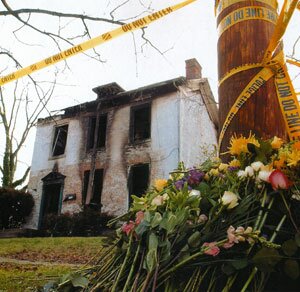
The off-campus residence near Miami University in Oxford, Ohio where Julie Turnbull and two others perished in 2005 was equipped with 17 ionization detectors.
PHOTO COURTESY CINCINNATI ENQUIRER
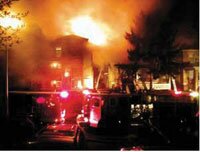
The 2003 fire that killed Andrea Dennis and four other students in an off-campus house at Ohio State University was deliberately set. The arsonist has never been arrested. The house was equipped with ionization detectors.
NEIGHBOR PHOTO
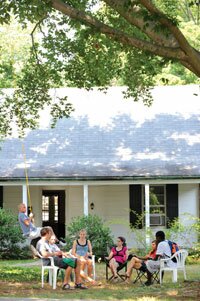
Approximately 70 percent of UVA's 21,000 students live in off-campus housing around the university. National statistics confirm that the vast majority– upwards of 90 percent– of American houses and apartments are equipped with ionization detectors, leaving residents unprotected from the deadliest type of fire.
PHOTO BY JEN FARIELLO

First years Waid Lester and Matt Perez live in Kellogg, which, like Cauthen and Woody residence halls, is protected by hardwired photoelectric detectors along with a back-up sprinkler system. UVA voluntarily switched from ionization units because of problems with false alarms.
PHOTO BY JEN FARIELLO

Recovery is ongoing for Ashley Mauter, who survived a house fire on Lewis Mountain Road in 2007.
FILE PHOTO BY JEN FARIELLO
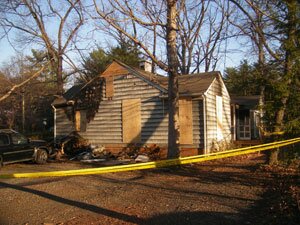
Although a survivor of the March 2007 fire in this Lewis Mountain Road duplex reported hearing the detector sounding as flames rapidly spread through his room, its alert came too late for two residents. Twenty-five year old Brett Quarterman died of his injuries, and his girlfriend Ashley Mauter received severe burns over 30 percent of her body.
FILE PHOTO BY HAWES SPENCER
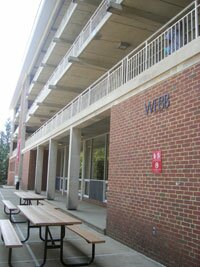
Webb residence hall is one of eight UVA dormitories still equipped with ionization detectors. According to Chief Housing Officer Mark Doherty, the school will be replacing those units with photoelectric units in phases over the next couple of years.
PHOTO BY COURTENEY STUART
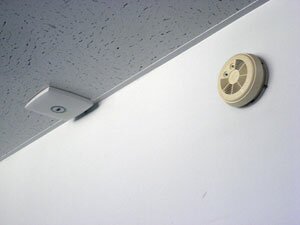
An ionization detector in Webb residence hall is affixed to the wall near the suite's wi-fi box.
PHOTO BY COURTENEY STUART
#